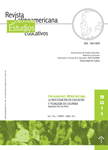Authors
Abstract
This article which is the result of a research project, shows the investigative tendencies in education and pedagogy in the Social Sciences, Childhood and Youth Doctoral Program which makes part of the Centro de Estudios Avanzados en Niñez y Juventud del Cinde y la Universidad de Manizales, as a partial sample of the final results of the research project “Investigative Regions in Education and Pedagogy in Colombia: Building an Investigative Activity Map in the Period 2000-2010” which took the Doctoral Program as a part of the sample. The study of the theses listed in this article was carried out through archival procedures for information collection, processing and analysis. Ten theses were studied in the Doctoral Program based on the following understanding emphasis: “Titles and Topics,” “Year in which the thesis was finished,” “Objectives,” “Methodological Options,” “Sources of Information,” and “Theoretical Perspectives” which resulted in the visualization of the investigative regions and their emergence.
Keywords:
References
Henao, M. & Castro, J. O. (Comp.) (2000). Estados del Arte de la Investigación en Educación y Pedagogía en Colombia 1989-1999, tomo II. Bogotá, D. C.: Colciencias, Icfes, Socolpe.
Martínez, E. & Vargas, M. (2002). La Investigación sobre la Educación Superior en Colombia. Bogotá, D. C.: Icfes.
Miranda, J. & Salazar, M. (2006). La construcción de una institucionalidad. Colombia: Ciencia y Tecnología, Colciencias, 3-4 (24).
Murcia, N. (2006). Universidad y vida cotidiana. Estudio desde imaginarios de profesores y estudiantes. Tesis doctoral distinguida con Magna Cun Lauda. Universidad de Manizales-Cinde.
Murcia, N. & Jaramillo, L. G. (2008). Investigación cualitativa. La complementariedad. Segunda edición. Armenia: Kinésis.
Peña, F. (compilador). (2007). Reflexiones acerca de la investigación en educación y pedagogía. Bogotá, D. C.: Universidad Pedagógica Nacional.
Pintos, J. L. (2002). “El metacódigo relevancia y opacidad en la construcción sistémica de lasrealidades”. Revista RIPS: Revista de investigaciones políticas y sociológicas, No 1-2., Vol. 2, pp. 2-34.
__________. (2004). Inclusión/exclusión. “Los imaginarios sociales de un proceso de construcciónsocial”. Revisión y ampliación de los elementos básicos de la teoría de los imaginarios sociales. Semata. Ciencias sociales y humanidades. Vol. 16, pp.17-52.
Rojas, H. M. & González, D. C. (2008). Lo visible en investigación pedagógica y educativa. Ibagué: Universidad de Ibagué.
Serres, M. (1995). Atlas: Cátedra.
__________. (2003). Los cinco sentidos: ciencia, poesía y filosofía del cuerpo. Bogotá, D. C.: Taurus.
__________. (2001). Lo virtual es la misma carne del hombre. Diario Le Monde, París, 18 de Junio de 2001.

 PDF (Español)
PDF (Español)
 FLIP
FLIP
















